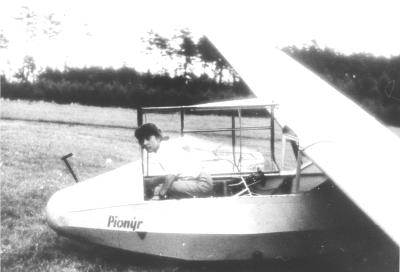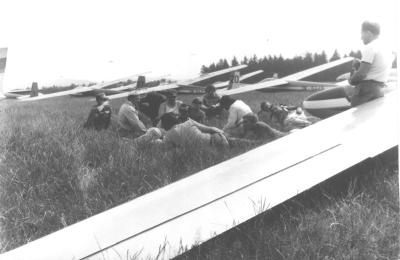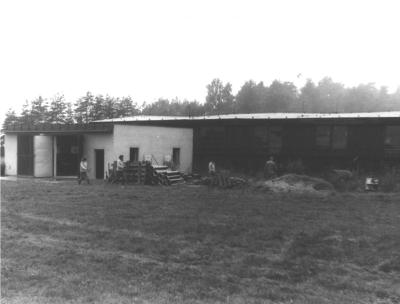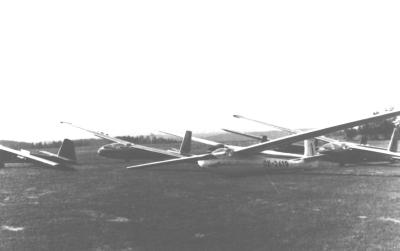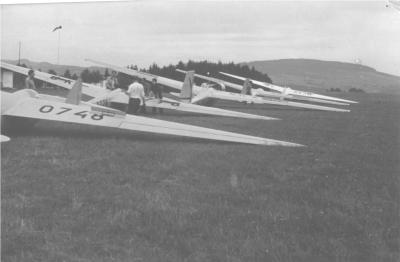Brief look in the life and history of the Hodkovice nad Mohelkou airfield
The beginning of flying in Hodkovice originates from 1936 when this location was found by fans of air sports. They had been trying the flying experiments already for two years in near-by spots: Hůrka, Kozákov, Všeň, Žemlovka etc. In 1936 they tried to use terrain Citeř, which was the original name of the Hodkovice-Vrchovina tableland. An edge, in direction to Petrašovice, was great for flying along it. These first steps were stopped by mobilization in 1938. The Nazi occupation meant prohibition of flying and ended these efforts.
Germans found the Hodkovice plateau as a realy good spot and established there a training airfield with two runways situated perpendicular to each other. They built an hangar on the top of Citeř, which was 10 x 30 metres big, and a wooden one on the other side near the Vrchovina hamlet, which was not entirely completed.
In 1945 the flying activity started again. The airfield was passed on ČNA which founded the gliding school ( Zemská plachtařská škola ) for planned expansion of glider pilot training. After the war, during the years of national freedom and progress, great enthusiasm grew for flying, predominantly among young people. They were motivated by the success of the Czech war pilots who were fighting in the U.K. and on the Eastern Front. At that time both healthy men or women could attend gliding course without any barriers. Traffic on the airfield was busy.
During week-days the airfield was filled by course attenders and during the weekends or holidays by extern soaring courses of different levels. In addition, there were also pilots with "C" awards who were joining the traffic. This was the period which any of the pilots will never forget. It was the time full of romantic and physical effort needed for that kind of flying. Gliders were put in the air by a rubber rope and muscles. And they were brought back to the start mostly by man power. Some of the witnesses tell about the cow, borrowed from a local farmer, which helped to pull the gliders up the steep hillside.
At that time, the club members finished the work on the incomplete hangar which was started by the Germans. After the war, some gliders were left there besides military equipment. These gliders were used for traning of the pilots. When the gliding school was canceled in 1950-1951, a lot of glider pilots moved to newly built airfields in the surroundings of Hodkovice.
The outflow of the glider pilots finished with the foundation of Svazarm when there was a reduction of airfields. Our airfield was one of the happier ones which survived this reduction.
The start of Svazarm also changed the thrust. The importance was more given to a defensive potential, not to sport flying. Members of the canceled airfields came to the Liberec or Lomnice n.P airfields, but mostly to Hodkovice. Some of the members were disappointed of the sport flying poor progress and finished their activities. A new crew of people at the Hodkovice airfield consisted mostly from experienced pilots from the canceled airfields. After the gliding school left from Hodkovice to Vrchlabí the gliding in Hodkovice was reduced and was limited by the insufficient airfield dimensions and surface roughness. Therefore, gliders were launched only by a winch. In the autumn 1953 the work started to enable to use the airfield for powered planes as well. The field work finished in the middle of 1954. At the same time the documentation for the Department of Transportation was prepared.
After two negotiations the powered planes flying was allowed. The first powered planes were moved to Hodkovice from Liberec in the same year. These were towing planes C-106 and K-68. In 1953-1954 the underground petrol tank was built. This became the base equipment for powered planes flying. There were new and new people interested in the gliding courses and so the airfield activities were growing.
The organisation was then marked as 'selective' that meant that not everybody could fly, just the more happy ones who had no relatives in the West. Although the outer behaviour of the clubs looked engaged in the propaganda, the inner club life was unpolitical and focused mainly on sport activities. Flying in our aeroclub was always linked with an active approach of all members to the economic needs, which were never fully covered by the state.
That was also the time when the clubs were left without all means except the aviation equipment. In spite of difficulties in obtaining enough finances, a lot was built with the help of the club members themselves. The ones, who are still the members but also the others who were members in the past, made a lot of work. They built a new hangar, a new underground tank, an oil store, a club house with a new extension, garages, waterpipes, electric connections, a guardhouse, a septic tank, a house in Hodkovice, an acces road to the airfield, etc.
We had also many successes in flying itself. There were pilots who started with proffesional or army flying. We organized some air shows and many flying contests.
Our pilots participated almost in all organized contests in other Czech aeroclubs. The biggest success was reached by Božena Tlapáková who won in a couple of national gliding champioships and by Hana Vokřínková who won Women's World Glidincg Championship in 2005 (Klix, Germany). There are also gliding camps for foreign pilots which take place on our airfield. The guest are coming, for example, from Germany, the Netherlands, Denmark or Switzerland. The whole season we offer sightseeing flights with powered planes and gliders. Everybody can start the flying courses on powered planes or gliders. Please ask fot the terms.
